Thoughts on Dancer In The Dark
A Genre-Blending Tour-de-Force
Dancer in the Dark won the Palm d'Or for Best
Picture at the 2000 Cannes Film Festival, and also secured
for its lead actress, pop singer Björk, the Best Female
Performance award. It is a most unusual film: a melodrama, shot
like a documentary, in which characters break out into song and
dance as in a musical. It's not even shot on film, director
Lars von Trier opting to use digital video instead, sometimes
employing as many as 100 cameras at once to capture a scene.
While interesting in their own right, all of Dancer in the
Dark's genre-blending experimental tendencies are used in the
service of a tale that packs an enormous, old-fashioned emotional punch.
Few movies are this emotionally potent. If you cry easily at films,
be warned.
I hadn't seen any of Danish director Lars von Trier's works before
watching Dancer In The Dark on DVD a couple of nights ago.
Von Trier is a central figure in the Dogme95 filmmaking movement, in
which Dogme95 filmmakers eschew all that is slick and phony in commercial
Hollywood films in an effort to get back to something raw and real.
Ironically, though, Dancer in the Dark is just as contrived
and manipulative as any film coming out of Tinseltown. What's different
about Dancer in the Dark is the unconventional means by
which von Trier achieves his manipulative power.
There's a scene in Dancer In The Dark in which Björk's
character, Selma, describes how a conventionally manipulative Hollywood
film tells us what to feel: "it goes really big and the camera goes,
like, out of the roof...," she says, making reference to the sweeping
camera moves and swelling strings on the soundtrack that mark a
conventional film's emotional landscape. By contrast, Dancer in
the Dark never manipulates us this way. Except in its fantasy
musical song-and-dance numbers, there is no underscore music of any
kind in this film, so dramatic moments are never coated with a thick
glop of syrupy violins. And, with one exception (discussed below),
there are no big camera sweeps or crane shots either.
Melodrama Anchored to Reality Through Cinematography
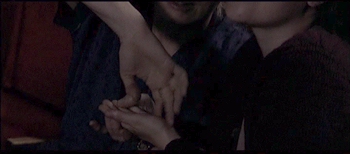 The film is shot like a documentary, with hand-held
cameras in a cinema vérité style that makes us feel more
like participants than observers, as if we were there in the room with
the characters as they are experiencing their most vulnerable, private
moments. With the camera so close, and the lack of distracting artifices
like a musical underscore or pristinely framed camerawork that comments
on the action, our full focus is directed instead to the characters'
words. And those words, more often than not, are delivered in hushed
intimacy, drawing us in with the power of a whisper. Our ability to
read the play of emotions across the characters' faces is also
heightened by this intimate cinematic style.
The film is shot like a documentary, with hand-held
cameras in a cinema vérité style that makes us feel more
like participants than observers, as if we were there in the room with
the characters as they are experiencing their most vulnerable, private
moments. With the camera so close, and the lack of distracting artifices
like a musical underscore or pristinely framed camerawork that comments
on the action, our full focus is directed instead to the characters'
words. And those words, more often than not, are delivered in hushed
intimacy, drawing us in with the power of a whisper. Our ability to
read the play of emotions across the characters' faces is also
heightened by this intimate cinematic style.
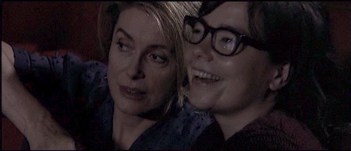 In a film shot this way, the smallest gestures can carry
meaning. Watching Catherine Deneuve's character, Kathy, cover her
mouth with her hand to stifle a worried cry as she sees a nearly blind
Selma use a railroad track to guide herself home communicates volumes.
The warmth of the scene in which Kathy dances two fingers across the
palm of Selma's hand at the movie theater to convey to her the essence
of the Busby Berkeley dance number playing out on the movie screen in
front of them, is similarly touching. And if the small moments like this
are emotionally effective, when the really bad stuff starts to happen,
there is a concomitant escalation of emotional involvement that makes
certain sequences almost too much to take.
In a film shot this way, the smallest gestures can carry
meaning. Watching Catherine Deneuve's character, Kathy, cover her
mouth with her hand to stifle a worried cry as she sees a nearly blind
Selma use a railroad track to guide herself home communicates volumes.
The warmth of the scene in which Kathy dances two fingers across the
palm of Selma's hand at the movie theater to convey to her the essence
of the Busby Berkeley dance number playing out on the movie screen in
front of them, is similarly touching. And if the small moments like this
are emotionally effective, when the really bad stuff starts to happen,
there is a concomitant escalation of emotional involvement that makes
certain sequences almost too much to take.
A New Mythic Model
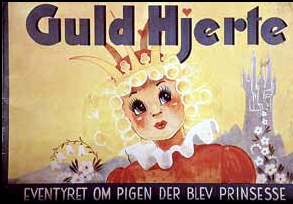 At some primal level, the story was inspired by Guld Hjerte (in English: Gold
Heart), a picture-book that Lars von Trier read as a child.
It tells the tale of a little girl who lives in a lonely cabin in the woods
who one day goes out into the forest and gives away everything she has.
In the end, broke, cold, and alone in the woods, at what should be her
deepest moment of despair, a mysterious power favors her with wealth;
and the boy she gave her sweater to turns out to be a prince, who marries
her for her kind heart.
At some primal level, the story was inspired by Guld Hjerte (in English: Gold
Heart), a picture-book that Lars von Trier read as a child.
It tells the tale of a little girl who lives in a lonely cabin in the woods
who one day goes out into the forest and gives away everything she has.
In the end, broke, cold, and alone in the woods, at what should be her
deepest moment of despair, a mysterious power favors her with wealth;
and the boy she gave her sweater to turns out to be a prince, who marries
her for her kind heart.
However, von Trier's copy of this book was missing the ending.
As a result, his impressionable young mind saw the tale as one of
simple self-sacrifice with no promise of reward, and it seems to
have become a potent mythic model for him. He's made three films
about female martyrdom -- Breaking The Waves, The
Idiots, and Dancer In The Dark -- which together he
calls his "Golden Heart Trilogy".
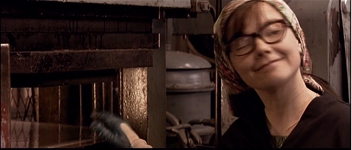 In Dancer In The Dark, Selma is a kind-hearted, mildly
retarded single mom with a congenital eye disease which is causing her to
go slowly blind. Her twelve year old son, Gene (as in "genetics", or,
as a friend pointed out, perhaps "Gene Kelly") doesn't know it yet, but
because the condition is genetic, he too is destined for blindness unless
he has an operation before his thirteenth birthday. Selma also believes
that it is necessary to keep Gene's condition a secret from him, otherwise
he might worry and that would lead to the disease becoming incurable.
In Dancer In The Dark, Selma is a kind-hearted, mildly
retarded single mom with a congenital eye disease which is causing her to
go slowly blind. Her twelve year old son, Gene (as in "genetics", or,
as a friend pointed out, perhaps "Gene Kelly") doesn't know it yet, but
because the condition is genetic, he too is destined for blindness unless
he has an operation before his thirteenth birthday. Selma also believes
that it is necessary to keep Gene's condition a secret from him, otherwise
he might worry and that would lead to the disease becoming incurable.
But Selma is a blue-collar immigrant laborer, so saving up the
thousands of dollars for Gene's operation means working multiple shifts of
a stifling job at the local metal-sink-making factory and taking home
additional mind-numbing work like hand filling 10,000 display cards with
hair-pins for whatever meager extra income she can get. She keeps her
savings, in cash, in a candy tin that she hides in the back of a closet
in the cramped trailer where she and her son live.
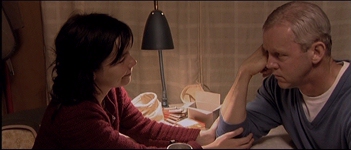 The trailer is parked on the property of a soft-spoken local police
officer, Bill, and his wife. One day, late at night, Bill comes to
Selma's trailer to confess that his wife, who thinks he is rich from an
inheritance, has unknowingly spent all their money, and that he is afraid
she will leave him when she finds out he is broke. He desperately needs
cash. Selma in turn confesses that, while her own impending blindness is
inevitable, she can save Gene's sight with an operation and is getting
close to having the necessary money to pay for it. And by now, I guess
you can see where this is going. In short, Selma has been set up as the
perfect victim, and indeed we spend the rest of this nearly two-and-a-half
hour film watching her be systematically victimized in ways that are
crushingly sad -- sad not only for their inherently tragic qualities,
but also because the childlike character of Selma very strongly engages
our protective instincts, so that we really don't want these
tragedies to befall her.
The trailer is parked on the property of a soft-spoken local police
officer, Bill, and his wife. One day, late at night, Bill comes to
Selma's trailer to confess that his wife, who thinks he is rich from an
inheritance, has unknowingly spent all their money, and that he is afraid
she will leave him when she finds out he is broke. He desperately needs
cash. Selma in turn confesses that, while her own impending blindness is
inevitable, she can save Gene's sight with an operation and is getting
close to having the necessary money to pay for it. And by now, I guess
you can see where this is going. In short, Selma has been set up as the
perfect victim, and indeed we spend the rest of this nearly two-and-a-half
hour film watching her be systematically victimized in ways that are
crushingly sad -- sad not only for their inherently tragic qualities,
but also because the childlike character of Selma very strongly engages
our protective instincts, so that we really don't want these
tragedies to befall her.
Emotions Take Us Farther Than Intellect
 As with
anything this strong, there is a fine line between tragedy and defensive
derision. I felt the film worked very powerfully at an emotional level,
but there will doubtless be others who find the whole thing nauseating
or laughably over-the-top. To submit to this film's power requires
the viewer to look past the shallowness of the plot to the emotional
throughline underneath. It ultimately doesn't matter if Selma's reason
for keeping Gene's impending blindness a secret from him makes any sense.
If you don't like the (rather flimsy) reason the filmmakers chose,
make up a better one yourself. The exact reason is unimportant. What's
important is that Selma believes the secret must be kept, and would
rather die than divulge it. Selma's commitment to keeping that secret
has an emotional truthfulness that far outweighs whatever plot McGuffin
is used to justify it at the story level. Viewers who can't or won't
make that leap of faith, will have a hard time getting anything out of
this movie. Lars von Trier has said that viewers can be taken farther
on their emotions than their intellects would consider reasonable.
To my mind, this film proves it.
As with
anything this strong, there is a fine line between tragedy and defensive
derision. I felt the film worked very powerfully at an emotional level,
but there will doubtless be others who find the whole thing nauseating
or laughably over-the-top. To submit to this film's power requires
the viewer to look past the shallowness of the plot to the emotional
throughline underneath. It ultimately doesn't matter if Selma's reason
for keeping Gene's impending blindness a secret from him makes any sense.
If you don't like the (rather flimsy) reason the filmmakers chose,
make up a better one yourself. The exact reason is unimportant. What's
important is that Selma believes the secret must be kept, and would
rather die than divulge it. Selma's commitment to keeping that secret
has an emotional truthfulness that far outweighs whatever plot McGuffin
is used to justify it at the story level. Viewers who can't or won't
make that leap of faith, will have a hard time getting anything out of
this movie. Lars von Trier has said that viewers can be taken farther
on their emotions than their intellects would consider reasonable.
To my mind, this film proves it.
A Fabulist's America as Seen by a European
Even before things go really bad, Selma's blue-collar existence would be
hard to bear. Indeed, her environs remind one not so much of America as
of the English Forest of Dean coal-mining towns and their blue-collar
inhabitants that regularly populate British writer Dennis Potter's
similarly dark screenplays (e.g., The Singing Detective
or the TV version of Pennies From Heaven (the one with
Bob Hoskins, not Steve Martin)).
If the cinema vérité style helps infuse the melodramatic
tale with a sense of realism, the story's plot contrivances are further
ameliorated by the fact that the "American" town in Washington state where
this film is supposed to be set, is no more convincingly American than
Jackie Chan's New York borough was in Rumble in the Bronx.
It is purely a constructed, artificial setting, and this actually makes
it easier for us in the audience to accept that it might carry with
it its own dramatic rules, as in a fable, a fantasy, or a sci-fi story.
Within its own constructed universe, the characters treat the events as
real in a convincing way (the acting throughout this film is stellar),
inviting us to believe them too. There is a weirdly effective irony
in shooting a film whose plot, characters, and settings are such obvious
artifices in a gritty, documentary style. Imagine if The Wizard
of Oz had been shot in a cinema vérité style, as
if Dorothy and the Tin Man had been mundanely real. I've rarely seen a
cinematic style so seemingly incompatible with its subject matter work
so well.
An Astonishing Contribution from Björk
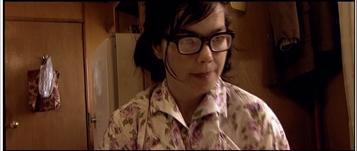 Björk's performance demands special accolades. It is amazingly
strong. The emotional demands it must have placed on her simply boggle
the mind. She never makes a misstep, giving a performance that is so
emotionally naked and raw that it is at times hard to watch. Her two
most horrifying sequences are absolutely riveting and project such a
complex mix of girlish vulnerability and matronly resolve, that I found
it impossible to avert my eyes from the emotional trainwreck unfolding
before me. Björk poured her soul into this performance and every
agonizing moment of it has been captured on screen. Of the film's
many strengths, Björk's turn as Selma ranks near the very top,
to the point where the film would be worth seeing just to witness the
intensity of her portrayal. The fact that she is not a trained actress
and that she is required to carry nearly every scene of this 141 minute
film, only makes Björk's accomplishments here even more impressive.
It is truly a performance I will not soon forget.
Björk's performance demands special accolades. It is amazingly
strong. The emotional demands it must have placed on her simply boggle
the mind. She never makes a misstep, giving a performance that is so
emotionally naked and raw that it is at times hard to watch. Her two
most horrifying sequences are absolutely riveting and project such a
complex mix of girlish vulnerability and matronly resolve, that I found
it impossible to avert my eyes from the emotional trainwreck unfolding
before me. Björk poured her soul into this performance and every
agonizing moment of it has been captured on screen. Of the film's
many strengths, Björk's turn as Selma ranks near the very top,
to the point where the film would be worth seeing just to witness the
intensity of her portrayal. The fact that she is not a trained actress
and that she is required to carry nearly every scene of this 141 minute
film, only makes Björk's accomplishments here even more impressive.
It is truly a performance I will not soon forget.
Her character Selma's only joy in life, outside of her son, is American
musicals. Indeed, her expectations of what America would be like seem to
be largely based upon American movies and especially American musicals
that she saw while still in Czechoslovakia. The disparity between the
naive magical America that the films propose, and the actual America she
inhabits as a poor, undereducated immigrant, is part of the tragedy of
her circumstances.
Although the America she finds herself in is nothing like the
America promised to her in the musicals she loves, her love for those
musicals continues unabated. Despite having absolutely no talent, and
not being able to even see well enough to walk across the stage, let
alone dance, she is happy to be rehearsing the part of Maria in a local
community theater production of The Sound of Music. With
her friend Kathy, she regularly goes to the movies to see old musicals.
And when life's drudgery gets to be too much for her, she fantasizes
that her life is a musical, where, as she puts it, "nothing dreadful
ever happens". This leads to a number of song and dance sequences,
for which Björk was tapped to write the music.
These musical numbers are not wholly effective, though they aren't as
ineffective as they at first appear either. They definitely lack the
slick sweep that they need to adequately contrast with the drab horrors
of Selma's real life. As escapist fantasies, most are too dark-toned
and earthbound. As one reviewer put it, they merely plod along when they need to soar.
But after repeated viewings, I've come to realize that only a couple
of the numbers are actually intended to be Selma's escapist fantasies.
Other numbers are more like amplifications of her current state of mind.
In fact, the strongest numbers are of this kind.
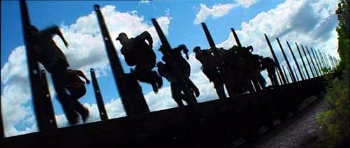 In her song, "I've Seen It All", she attempts to convince her
would-be suitor, Jeff, that she doesn't care that she's going blind.
It's couched as a dialog between the two of them in which they catalog the
various sites that Selma has or hasn't yet seen. On the surface, this
song appears to be a simple, traditional catalog song in the mold of "My
Favorite Things" or "Seventy-Six Trombones." These songs, in which the
lyrics rattle off lists or catalogs of things (e.g., "Raindrops on
roses and whiskers on kittens, ...") are common in musicals. "I've Seen
it All", however, contains an uncommonly complex mix of emotions.
It derives much of its power from our realization that Selma is most
likely trying to convince herself as much as Jeff. But we also realize
that going blind is truly awful for her, because why else would she have
sacrificed so much to save her son from that fate? And yet, at another,
more profound level, she has already accepted her impending blindness,
and so it truly is no longer important -- only saving her son
from going blind matters now. The song effectively encapsulates
these conflicting thoughts and presents them with a compelling
combination of hopefulness and resignation.
In her song, "I've Seen It All", she attempts to convince her
would-be suitor, Jeff, that she doesn't care that she's going blind.
It's couched as a dialog between the two of them in which they catalog the
various sites that Selma has or hasn't yet seen. On the surface, this
song appears to be a simple, traditional catalog song in the mold of "My
Favorite Things" or "Seventy-Six Trombones." These songs, in which the
lyrics rattle off lists or catalogs of things (e.g., "Raindrops on
roses and whiskers on kittens, ...") are common in musicals. "I've Seen
it All", however, contains an uncommonly complex mix of emotions.
It derives much of its power from our realization that Selma is most
likely trying to convince herself as much as Jeff. But we also realize
that going blind is truly awful for her, because why else would she have
sacrificed so much to save her son from that fate? And yet, at another,
more profound level, she has already accepted her impending blindness,
and so it truly is no longer important -- only saving her son
from going blind matters now. The song effectively encapsulates
these conflicting thoughts and presents them with a compelling
combination of hopefulness and resignation.
Her "107
Steps" song has a fatalistic function similar to that of classical
minimalism as used in films like Gattaca or The Cook,
The Thief, His Wife, and Her Lover. The song's ever-ascending
counting from 1 to 107 is like the countdown of a clock and signals the
unstoppable forward momentum leading toward the impending tragedy that
awaits her. The fantasies of affection and kindness she imagines while
this counting plays out, and the hopefulness for a happy ending that
would be possible if this sequence were part of a classic 1940's musical,
are twice as tragic for our knowledge that this is not a classic musical,
and no such happy-ending hope is warranted. Even so, when the inevitable
end comes, it still seems shocking for a movie to be willing to take
things so far. Even Dennis Potter, who brought his Pennies From
Heaven characters to the brink, didn't, in the end, shove them
over the edge.
The Look of Her Dreams
In capturing the dance numbers on tape, von Trier has made some
interesting cinematic choices. First, in contrast to the hand-held
camera used in the rest of the movie, the fantasy sequences were shot
instead with multiple cameras none of which employ any camera motion
at all -- no pans, no zooms. The cinematic rhythm of the sequences is
provided almost entirely by the pace of cuts made from one static camera
viewpoint to another.
Von Trier's reasoning was that by setting up a lot of cameras (as many a 100
in some shots) and allowing the action to pass in front of them (or not), he
would retain a sense of capturing a "live" event and deny himself the mannered,
sweeping crane shots or other clichéd camerawork that would normally
be utilized to film a song-and-dance sequence in a traditional musical.
And it must be said that this technique has some very positive qualities.
For one, it works marvelously at a metaphoric level, allowing us to feel
viscerally that Selma is only on stable ground while in her fantasy world.
Outside of her daydreams, amidst the bobbing handheld camera work, we
see, feel, and experience along with her, her sense of her life slowy
shaking out of control. In this sense, the static immobility of the
"100 Cameras" technique works by direct contrast with the cinema
vérité style used in the rest of the film.
The technique also offers a very effective, omniscient point of view
from which to witness Selma's manifest fantasies. Choreographer Vincent
Paterson points out on the commentary track during the "I've Seen It
All" sequence, that we are able to see Selma climb onto the train from a
collection of images cut together from a large number of perspectives, all
of which could be from the same take of Björk's performance.
This is made possible only because there were so many cameras capturing
that performance, each from a different angle. Seeing the sequence of her
climbing onto the train from a dozen or so perspectives in the span of a
couple of seconds really helps release the sequence from physical bounds.
That is, it makes it seem believably dreamlike because it un-anchors us as
viewers from any one viewpoint associated with a specific physical place.
We effectively view it with a "mind's-eye", all-perspectives-at-once view,
more consistent with a dream reality than physical reality.
Which is all well and good, but it must also be said that in many instances,
the earthbound, immobile camera perspectives, more so than the music, are
responsible for the overall impression of the dance sequences lacking sweep.
Von Trier has said that one of the things he learned from using the "100
cameras" technique is that a hundred cameras isn't enough -- he'd like to
have had a thousand or even ten thousand. Perhaps with greater coverage
of the event, from more angles and perspectives, this technique can be
improved upon in the future to address some of the problems with the
scenes feeling constricted. But as used in Dancer In The Dark, I
feel the technique is something of a mixed bag.
Fortunately, camerawork isn't the only thing that distinguishes Selma's
fantasies from her reality. The color palette expands greatly in her
fantasy sequences, taking her (and us) out of her desaturated, drab world
into a place of much greater color vibrancy. Additionally, the surround
channels in the sound system, which are generally quiescent during the
bulk of the film, engage dramatically for these scenes.
All of these techniques make the return to reality from her fantasy
sequences especially hard from an emotional/psychological standpoint.
As we, along with Selma, come crashing out of her reveries, we start to
realize how much inner strength is demanded of her just to continue moving
forward in the cruel harshness of her real life, a harshness which is
made more evident by its contrast with her warm, brightly colored dreams.
Near the end of the film, these contrasting shooting styles take on
additional storytelling power. There are two songs sung by Selma a
cappella. In the first, she sings "My Favorite Things" (from The
Sound of Music), and when she begins, the camerawork switches to
the locked-down "100 cameras" style, indicating that she is escaping once
again from her grim reality into the saftey and comfort of song. Two
song-sequences later, though, in even more dire circumstances, she again
begins to sing a cappella, but this time the cinematography stubbornly
refuses to switch to the "100 cameras" style, signalling to us that,
finally, Selma's circumstances are so grim that even the power
of music and fantasy cannot make things right for her. If you've stuck
with the film to this point, the combination of Björk's phenomenal
acting, Selma's desperate singing, and the refusal of the camerawork to
look away, conveys her tragedy with a powerful, almost operatic intensity.
Curtains for Selma
There are some nice touches in the way the film is constructed too.
Everywhere except in the United States, Dancer In The
Dark opens with a musical overture sans image. When von Trier
learned that many movie screens in American theaters didn't have curtains,
he added a montage of paintings sequence to accompany the opening overture
for American audiences. However, his original idea was that the overture
would play out in darkness with the theater curtains drawn. They would
open dramatically at the close of the overture.
Understanding this, then, allows one to appreciate the symmetry of the
ending scene, in which curtains are drawn closed just before the camera
makes its one and only crane shot. As Selma pointed out, you know the
film is going to end when the camera goes through the roof, and that's
exactly what it ultimately does.
Sadness as Catharsis; Death as Transcendence
Because of his willingness to put his saintly, childlike main
character through such heaping helpings of emotional agony, von Trier
has been accused of being merely sadistic. I never felt that sadism
was the operating force in this film, though, and certainly not in the
mean-spirited, puerile way that Paul Verhoeven's films regularly display.
Nevertheless, one has to wonder at the end what von Trier's point is.
What are we supposed to take away from watching this wrenching tale
of woe?
Sadness can, of course, be cathartic, and there is a sense in
which Selma's life-goal -- to save her son from blindness -- is ultimately
achieved. Since that was her only reason for living, her sacrifice
could be read as a release from earthly suffering earned by the good
deed she did (Jude Law's character's final act in Gattaca
could be read the same way, for example).
The film is also a poignant love song to the power of music, fantasy,
imagination and hope, to make life bearable.
Highly Recommended
If a movie which provokes an extremely
powerful sadness in its viewers won't frighten or embarrass you, then
I highly recommend this DVD. Just be prepared to be depressed when the
end credits roll, and to have its images and harrowingly emotional scenes
rattle around in your head long after the disc is back on the shelf. This
film lingers in the mind, and has haunted me for days since watching it.
And, although I'd seen and enjoyed other dramas shot with hand-held
cameras (particularly Barry Levinson's Homicide TV
series, which Lars von Trier cites as one of his formative influences),
Dancer In The Dark utilized this technique to such powerful
ends that it has completely changed my view about the grammar of
cinematography. This movie makes a compelling case for what von Trier
calls "transmission" as opposed to the carefully choreographed and therefore
more artificial and distancing cinematography used in traditional
moviemaking. I think I will have a hard time watching traditional
cinematography after experiencing what is possible with a handheld camera.
What more can I say? As this film continues to settle in my memory,
it grows in stature. It's too dark to ever be a popular film that
appeals to the masses, but it wouldn't surprise me if, ten years from
now, directors of popular films were cribbing techniques used here and
citing Dancer in the Dark as a potent influence that
changed the way they thought about their craft.
Copyright 2002 Ray Cole
Other reviews by Ray Cole: [Movies] [Music]
 In a film shot this way, the smallest gestures can carry
meaning. Watching Catherine Deneuve's character, Kathy, cover her
mouth with her hand to stifle a worried cry as she sees a nearly blind
Selma use a railroad track to guide herself home communicates volumes.
The warmth of the scene in which Kathy dances two fingers across the
palm of Selma's hand at the movie theater to convey to her the essence
of the Busby Berkeley dance number playing out on the movie screen in
front of them, is similarly touching. And if the small moments like this
are emotionally effective, when the really bad stuff starts to happen,
there is a concomitant escalation of emotional involvement that makes
certain sequences almost too much to take.
In a film shot this way, the smallest gestures can carry
meaning. Watching Catherine Deneuve's character, Kathy, cover her
mouth with her hand to stifle a worried cry as she sees a nearly blind
Selma use a railroad track to guide herself home communicates volumes.
The warmth of the scene in which Kathy dances two fingers across the
palm of Selma's hand at the movie theater to convey to her the essence
of the Busby Berkeley dance number playing out on the movie screen in
front of them, is similarly touching. And if the small moments like this
are emotionally effective, when the really bad stuff starts to happen,
there is a concomitant escalation of emotional involvement that makes
certain sequences almost too much to take.  The film is shot like a documentary, with hand-held
cameras in a cinema vérité style that makes us feel more
like participants than observers, as if we were there in the room with
the characters as they are experiencing their most vulnerable, private
moments. With the camera so close, and the lack of distracting artifices
like a musical underscore or pristinely framed camerawork that comments
on the action, our full focus is directed instead to the characters'
words. And those words, more often than not, are delivered in hushed
intimacy, drawing us in with the power of a whisper. Our ability to
read the play of emotions across the characters' faces is also
heightened by this intimate cinematic style.
The film is shot like a documentary, with hand-held
cameras in a cinema vérité style that makes us feel more
like participants than observers, as if we were there in the room with
the characters as they are experiencing their most vulnerable, private
moments. With the camera so close, and the lack of distracting artifices
like a musical underscore or pristinely framed camerawork that comments
on the action, our full focus is directed instead to the characters'
words. And those words, more often than not, are delivered in hushed
intimacy, drawing us in with the power of a whisper. Our ability to
read the play of emotions across the characters' faces is also
heightened by this intimate cinematic style. At some primal level, the story was inspired by
At some primal level, the story was inspired by  In Dancer In The Dark, Selma is a kind-hearted, mildly
retarded single mom with a congenital eye disease which is causing her to
go slowly blind. Her twelve year old son, Gene (as in "genetics", or,
as a friend pointed out, perhaps "Gene Kelly") doesn't know it yet, but
because the condition is genetic, he too is destined for blindness unless
he has an operation before his thirteenth birthday. Selma also believes
that it is necessary to keep Gene's condition a secret from him, otherwise
he might worry and that would lead to the disease becoming incurable.
In Dancer In The Dark, Selma is a kind-hearted, mildly
retarded single mom with a congenital eye disease which is causing her to
go slowly blind. Her twelve year old son, Gene (as in "genetics", or,
as a friend pointed out, perhaps "Gene Kelly") doesn't know it yet, but
because the condition is genetic, he too is destined for blindness unless
he has an operation before his thirteenth birthday. Selma also believes
that it is necessary to keep Gene's condition a secret from him, otherwise
he might worry and that would lead to the disease becoming incurable.
 The trailer is parked on the property of a soft-spoken local police
officer, Bill, and his wife. One day, late at night, Bill comes to
Selma's trailer to confess that his wife, who thinks he is rich from an
inheritance, has unknowingly spent all their money, and that he is afraid
she will leave him when she finds out he is broke. He desperately needs
cash. Selma in turn confesses that, while her own impending blindness is
inevitable, she can save Gene's sight with an operation and is getting
close to having the necessary money to pay for it. And by now, I guess
you can see where this is going. In short, Selma has been set up as the
perfect victim, and indeed we spend the rest of this nearly two-and-a-half
hour film watching her be systematically victimized in ways that are
crushingly sad -- sad not only for their inherently tragic qualities,
but also because the childlike character of Selma very strongly engages
our protective instincts, so that we really don't want these
tragedies to befall her.
The trailer is parked on the property of a soft-spoken local police
officer, Bill, and his wife. One day, late at night, Bill comes to
Selma's trailer to confess that his wife, who thinks he is rich from an
inheritance, has unknowingly spent all their money, and that he is afraid
she will leave him when she finds out he is broke. He desperately needs
cash. Selma in turn confesses that, while her own impending blindness is
inevitable, she can save Gene's sight with an operation and is getting
close to having the necessary money to pay for it. And by now, I guess
you can see where this is going. In short, Selma has been set up as the
perfect victim, and indeed we spend the rest of this nearly two-and-a-half
hour film watching her be systematically victimized in ways that are
crushingly sad -- sad not only for their inherently tragic qualities,
but also because the childlike character of Selma very strongly engages
our protective instincts, so that we really don't want these
tragedies to befall her.
 As with
anything this strong, there is a fine line between tragedy and defensive
derision. I felt the film worked very powerfully at an emotional level,
but there will doubtless be others who find the whole thing nauseating
or laughably over-the-top. To submit to this film's power requires
the viewer to look past the shallowness of the plot to the emotional
throughline underneath. It ultimately doesn't matter if Selma's reason
for keeping Gene's impending blindness a secret from him makes any sense.
If you don't like the (rather flimsy) reason the filmmakers chose,
make up a better one yourself. The exact reason is unimportant. What's
important is that Selma believes the secret must be kept, and would
rather die than divulge it. Selma's commitment to keeping that secret
has an emotional truthfulness that far outweighs whatever plot McGuffin
is used to justify it at the story level. Viewers who can't or won't
make that leap of faith, will have a hard time getting anything out of
this movie. Lars von Trier has said that viewers can be taken farther
on their emotions than their intellects would consider reasonable.
To my mind, this film proves it.
As with
anything this strong, there is a fine line between tragedy and defensive
derision. I felt the film worked very powerfully at an emotional level,
but there will doubtless be others who find the whole thing nauseating
or laughably over-the-top. To submit to this film's power requires
the viewer to look past the shallowness of the plot to the emotional
throughline underneath. It ultimately doesn't matter if Selma's reason
for keeping Gene's impending blindness a secret from him makes any sense.
If you don't like the (rather flimsy) reason the filmmakers chose,
make up a better one yourself. The exact reason is unimportant. What's
important is that Selma believes the secret must be kept, and would
rather die than divulge it. Selma's commitment to keeping that secret
has an emotional truthfulness that far outweighs whatever plot McGuffin
is used to justify it at the story level. Viewers who can't or won't
make that leap of faith, will have a hard time getting anything out of
this movie. Lars von Trier has said that viewers can be taken farther
on their emotions than their intellects would consider reasonable.
To my mind, this film proves it.  Björk's performance demands special accolades. It is amazingly
strong. The emotional demands it must have placed on her simply boggle
the mind. She never makes a misstep, giving a performance that is so
emotionally naked and raw that it is at times hard to watch. Her two
most horrifying sequences are absolutely riveting and project such a
complex mix of girlish vulnerability and matronly resolve, that I found
it impossible to avert my eyes from the emotional trainwreck unfolding
before me. Björk poured her soul into this performance and every
agonizing moment of it has been captured on screen. Of the film's
many strengths, Björk's turn as Selma ranks near the very top,
to the point where the film would be worth seeing just to witness the
intensity of her portrayal. The fact that she is not a trained actress
and that she is required to carry nearly every scene of this 141 minute
film, only makes Björk's accomplishments here even more impressive.
It is truly a performance I will not soon forget.
Björk's performance demands special accolades. It is amazingly
strong. The emotional demands it must have placed on her simply boggle
the mind. She never makes a misstep, giving a performance that is so
emotionally naked and raw that it is at times hard to watch. Her two
most horrifying sequences are absolutely riveting and project such a
complex mix of girlish vulnerability and matronly resolve, that I found
it impossible to avert my eyes from the emotional trainwreck unfolding
before me. Björk poured her soul into this performance and every
agonizing moment of it has been captured on screen. Of the film's
many strengths, Björk's turn as Selma ranks near the very top,
to the point where the film would be worth seeing just to witness the
intensity of her portrayal. The fact that she is not a trained actress
and that she is required to carry nearly every scene of this 141 minute
film, only makes Björk's accomplishments here even more impressive.
It is truly a performance I will not soon forget.  In her song,
In her song,